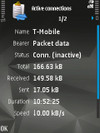Back in 2000, most of us in the industry thought that by 2012 or so, GSM would be on a good way to become history in Europe and elsewhere, having been replaced by 3G and whatever came afterward. Now in 2008, it's clear that this won't be the case. About a year ago, I published an article to look at the reasons why this has not happened. With LTE now at the doorstep, however, it has to be asked how mobile operators especially in Europe can support three radio technologies (GSM, UMTS/HSPA and LTE) into the foreseeable future.
While over the next few years, many network operators will transition their customer base to 3G handsets and thus might be able to switch off GSM from that point of view, there are a number of factors that will make them think twice:
- There might still be a sizable market for customers who are not willing to spend a great deal on handsets. Fact is that additional hardware and licenses for combined GSM/UMTS prevent such handsets for becoming as cheap as very basic GSM only handsets.
- Operators are keen on roaming charges from subscribers with 2G only handsets, this is a very profitable business.
- Current 3G networks are transmitting on 2.1 GHz and as a result the inhouse coverage of 3G networks is much inferior to current GSM networks. Putting more base stations in place could help to some degree but it's unlikely to be a cost effective solution.
In other words, in order to switch GSM off (whenever that might be) a number of things need to fall in place first, i.e. needs to be part of an operator's strategy:
- 3G must be used on a wide scale in the 900 MHz band (or 850 MHz respectively in the US and elsewhere). This, however, requires new mobile devices as only few models currently support this band. At this point in time it is not clear if national regulators will allow the use of 3G networks in the 900 MHz band in all European countries because it has significant implications on the competition with other technologies. Note: 4G deployment in 900/850 MHz is unlikely to help due to the voice gap discussed here.
- An alternative could be that combined DSL/Wi-Fi/3G Femtos become very successful in the market, which could compensate for missing 900 MHz coverage. But I am a bit skeptical if they can become that successful.
- Most roamers would suddenly pop-up with 3G capable handsets. I don't see that happening in the near- to mid-term either due to many countries not going down the 3G route and even for 900 MHz. Also, roamers with mobiles from places such as North America use different 3G frequencies and thus would not work in Europe and elsewhere and of course vice versa. Maybe this will change over the next couple of years two, but except for data cards, I haven't seen a big push for putting 3G on 850/900/1700/1900/2100 into handhelds.
At some point, however, it might become less and less economical to run a full blown GSM network alongside UMTS/HSPA and LTE networks despite lucrative 2G roamers and better inhouse coverage on 900 MHz. I see several solutions to this:
- Since GSM traffic declines in favor of 3G it will be possible at some point to reduce the capacity of the GSM network. At this point, separate GSM, UMTS and LTE base station cabinets could be combined into a single box. Base station equipment keeps shrinking so it is conceivable that at some point the GSM portion of a base station will only take little space. By using a single antenna casing with several wideband antennas inside could keep the status quo in the number of antennas required to run three network technologies alongside each other. Cabling could also be kept fairly constant with techniques that combine the signal to/from the different antennas over a single feeder link. For details have a look at my post on the discussion I recently had with Kathrein.
- Maybe advances in software defined radio (SDR) will lift the separation in base station cabinets between the different radio technologies. Should this happen, one could keep GSM alive indefinitely. SDR is discussed in the industry for many years now. Since I am not a hardware/radio expert I can't judge if and when this might become part of mainstream base stations.
- And yet another interesting idea I heard recently is that at some point two or more operators in a country might think about combining their GSM activities and instead of running several networks, only a single GSM network is maintained by all parties involved . As this network is just in place to deal with the roamers and the super low ARPU users (and maybe still lacking inhouse coverage), it is unlikely that this network will be upgraded with new features over time, so it could be pretty much static. So running such a combined network might be a lot easier than running a combined 3G network to save costs.
So what is your opinion, which scenario is the likeliest?
